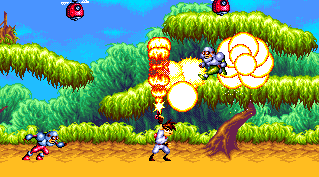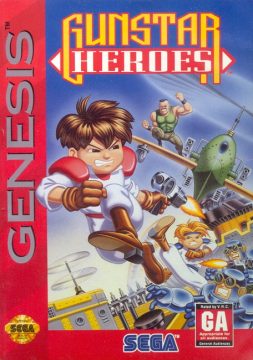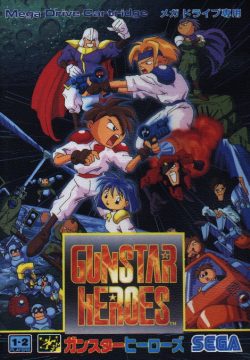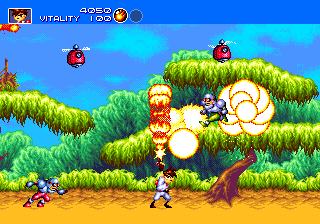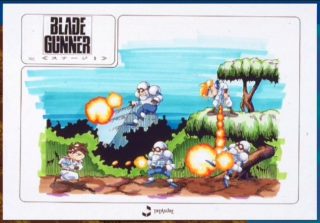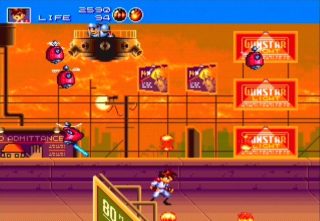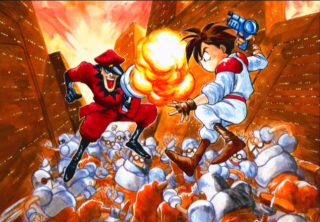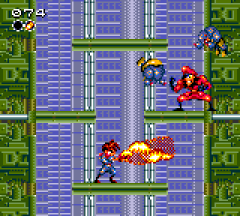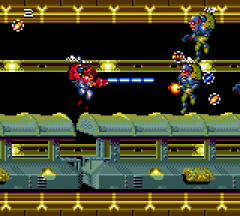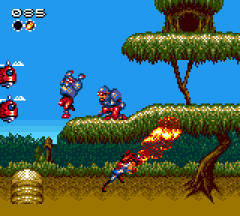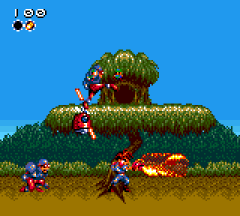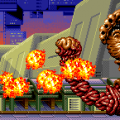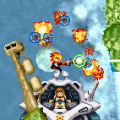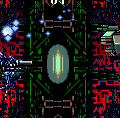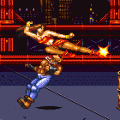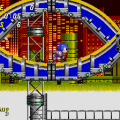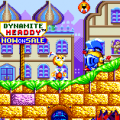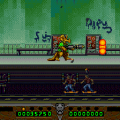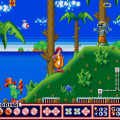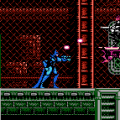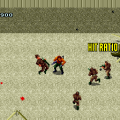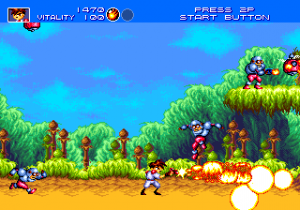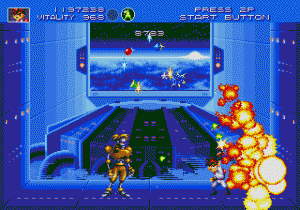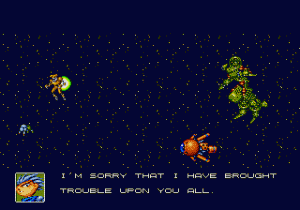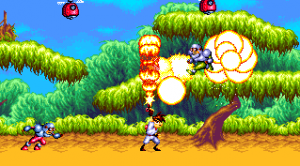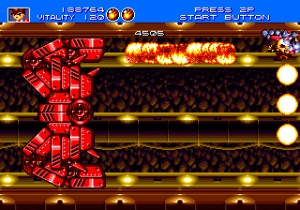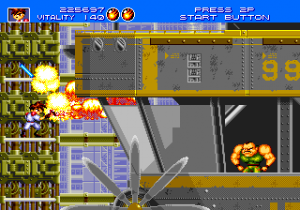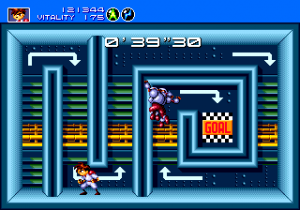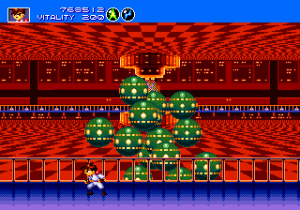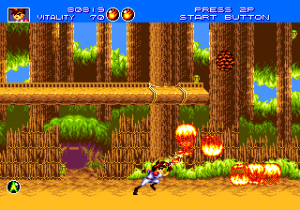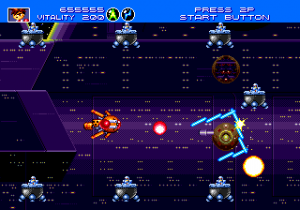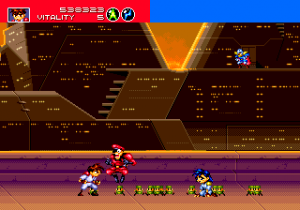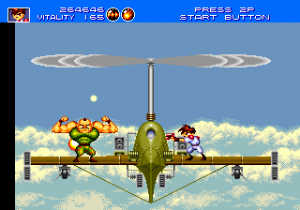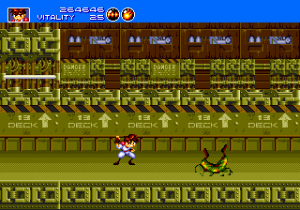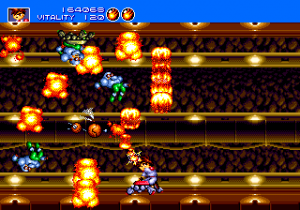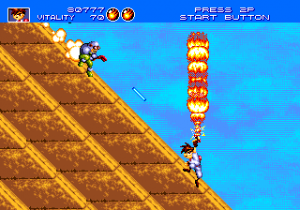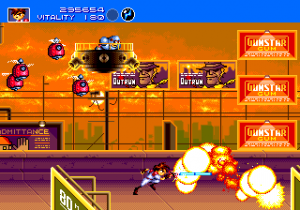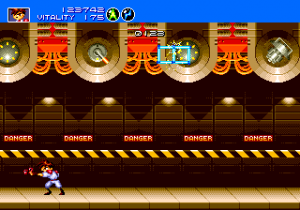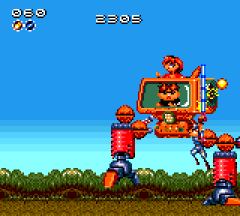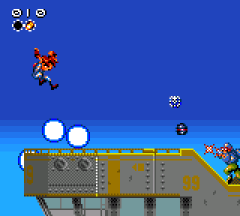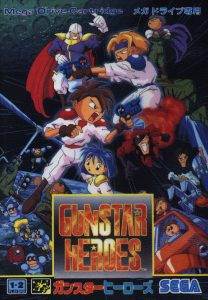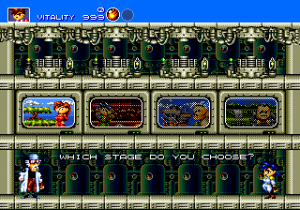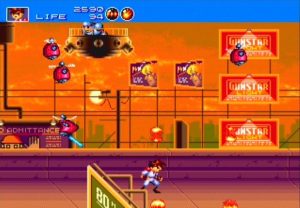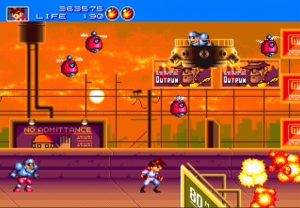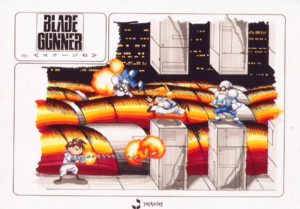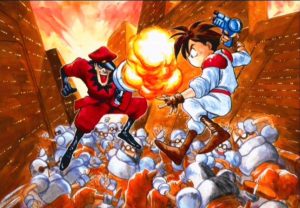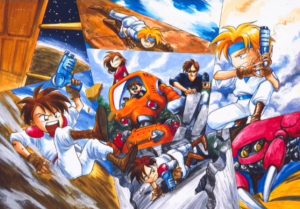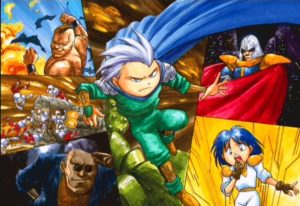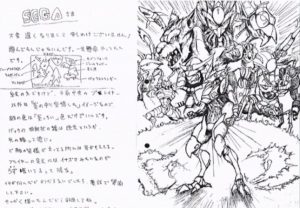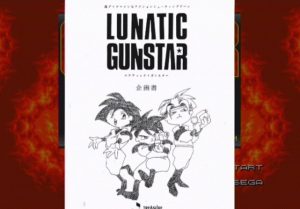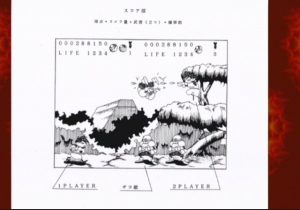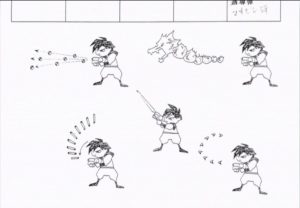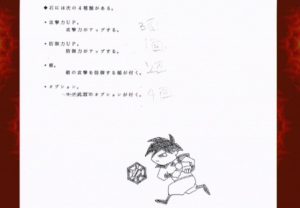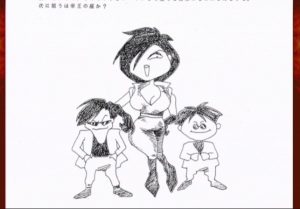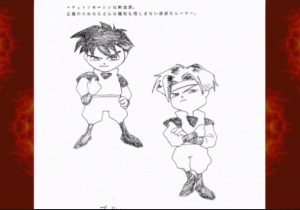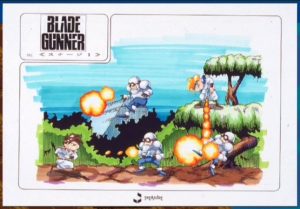- Gunstar Heroes
- Gunstar Super Heroes
Konami is one of the premier Japanese video game developers and publishers. Whether you are a fan of their games or not, you have to admit that they have a very diverse and strong track record. Castlevania, Contra, Gradius, Metal Gear Solid, Dance Dance Revolution, Snatcher, Rocket Knight Adventures, even Winning Eleven. Konami does it all and generally does it well. By coincidence, Konami has also given gamers another gift…
In 1992, Masato Maegawa and several of his fellow programmers, designers and artists, many of whom had worked on some of Konami’s greatest 16-bit achievements on the SNES, decided to leave the safe confines of the company and embark on their own little creative venture. The focus of the new company, christened Treasure, would be on making original, totally compelling games. It could be argued that many of Treasure’s “innovations in play mechanics” are gimmicky in practice, it was a grandiose, yet admirable notion that has resulted in some great software.
Having found a first home as a second party developer for Sega, Treasure made their impressive debut on the Sega Genesis with the excellent Gunstar Heroes, which consequently has gotten the most coverage of any of their games over the years. In terms of gameplay, it was the perfect starting point for the company, as several team members had been involved in the development of the excellent Contra Spirits/Contra III: The Alien Wars; arguably one of the best “run ‘n gun” games ever. If Contra was the benchmark, Gunstar Heroes sought to break the mold, while still offering a familiar and entirely organic play experience. Most anyone who tries this game can instantly see how great it is. While the visuals have now crossed into the realm of retro, Gunstar Heroes is so well executed that even the most jaded of the post-PlayStation generation of gamers have to give pause.
The story involves a bunch of crystals being stolen by an evil empire, but at the core are the titular Gunstar Heroes, Red and Blue. They fight against a variety of villains, all named after colors – the femme fatale Pink and her lackeys; the military strongman Orange; the skeezy gambler Black; and the wiz pilot Green, who is actually the brother of the Gunstar folks who’s turned against them. Leading them is the evil Emperor Gray and his subordinate Smash Daisaku, a cackling madman who looks a bit like M. Bison and has no qualms with sacrificing his own soldiers to beat those pesky Gunstar Heroes.
As is the case with most games in the run ‘n gun genre, Gunstar Heroes is light on narrative, but heavy on action. What it lacks in the plot department is deftly compensated for in the areas of visuals, sound and gameplay. From the opening polygonal Treasure logo, Gunstar Heroes never stops delivering the goods. The multi-sprite, multi-stage boss characters would become a Treasure trademark. The character art, masterfully created by in-house artist Tetsukiko Kikuchi (HAN), instantly delivers a unique and, quite frankly, strange stylistic bent that has been woven through almost all of their original properties to date. There is never a dull moment, as the screen is filled with perpetual explosions superimposed over richly detailed, multi-scrolling backgrounds. Impressively, with all manner of pyrotechnics happening on a constant basis, the game never slows down. It may seem quaint in the face of next-gen, but at the time it was quite striking.
The soundtrack of Gunstar Heroes is equally as exciting and unique. Featuring compositions by their resident maestro, Norio Hanazawa (NON), the music has a quality that can be best described as epic & inspiring, with a nod to the tongue-in-cheek. The various synth voices chosen also have their own unique sound and style, a trend that would continue throughout their Mega Drive output. Sound effects are equally as effective, with nice bass and some decent voice samples. Gunstar Heroes is one of those games that fully illuminates the potential of the Genesis sound chip.
The gameplay is standard run, jump and shoot, but somehow it manages to be so much more. One of the things that makes Gunstar Heroes stand out from other run ‘n gun titles is the amount of actions you can perform with your characters. If you’re close enough to a bad guy, you can pick them up and sling them at other bad guys. It’s pretty handy for grabbing bombs in mid-air and tossing them back at the attacker! You can also slide and execute body slams or jump kicks, which do an astounding amount of damage. If you’re playing two player, you can even chuck your pal across the screen, without damaging him at all! At the beginning of the game, you can choose the option of fixed or free aiming – do you want to aim your shots carefully while standing still or be able to run and shoot at the same time? Unfortunately you can’t change you mind mid-game. These little touches, coupled with the design decision of doing away with instant death or damage from enemy contact, allow the player to develop their own technique; a freedom not offered by many games of this type.
Another important advantage Gunstar Heroes has is its weapon system, which is deep and incredibly well implemented. There are four basic weapon types – flame, lightning, homing and force – that can be used in any combination of two. This means there are sixteen different weapons in total, including super flamethrowers, napalm shots, and short range laser swords. Though the combo of the blue laser & green homing shot is admittedly broken – it can track and destroy everything on screen with minimal user input – the ability to mix & match livens things up quite a bit, and adds greatly to the replayability.
There is also a decent bit of variety throughout the stages; many of which have been done before in one way or another, though never quite so well. The second level, with its breakneck magnetic mine car ride and incredible boss fight, with the now-famous Seven Force, is something that everyone simply needs to experience. It’s a gigantic robot with the ability to transform into seven different mechas, such as a phoenix or a huge revolver. Black’s palace is represented as a board game, with each square containing some kind of brief, unique challenges. In one, you need to destroy a vehicle as fast as possible. Another is an obstacle course. Yet another is a fight against a tiny robot a fraction of your size that can still toss you across the screen. One square totally bans weapons. Lots of them are completely crazy and just go to show off some of the fancy effects that Treasure decided to stick in. The horizontal shoot ’em up stage that takes place later on is also quite fun and well designed enough to be its own game. The final stage begins with all of the bosses watching your attack on a gigantic television screen. After you fight through them, one by one, they’re called out of the control room and into battle, before you finally storm in there yourself to confront the last boss. Every element is so well crafted that it seems much larger than its seven stages. You can also pick the order in which to tackle the first four stages, and beating each one will extend your starting HP by 20 points.
Gunstar Heroes also introduced a number of elements that have been seen throughout other Treasure games. Most notably is its preference for using numeric life gauges, rather than standard life bars. It’s also unique compared to other shooters due mostly to its looseness. In Contra, your heroes are killed after a single hit, demanding exact precision to dodge enemy fire or overpower quick moving bosses. Gunstar Heroes is much more forgiving, and doesn’t require nearly the same amount of reflexive intensity. While one could argue that it makes their games simpler, on the flip side, their relaxed approach actually make them a lot more fun, where you can concentrate more on the joys that come with dealing expansive amounts of damage without worrying too much about memorizing enemy patterns. That’s not to say Gunstar Heroes is an easy game – on the hardest difficulty level, it’s still quite a challenge – but this attitude contrasts greatly to Konami’s Contra: Hard Corps, released in a similar time period for the Genesis; a game that, despite containing the same unbridled enthusiasm as Gunstar Heroes, is so brutal and unforgiving that it’s practically unplayable to all but the most dedicated gamers.
Gunstar Heroes recently received a re-release of sorts on the PS2 with the Sega Ages Treasure Box. The port is excellent, with many display options available if you’re a stickler, including progressive scan mode, true low-res, and a scanline mode. Only the sound suffers a bit due to the notoriously difficult to emulate Mega Drive sound chip. There are also extensive galleries with pictures of all versions from all territories, including full manual scans and a lot of cool concept art for Gunstar Heroes. You can also unlock the original design document, which has all kinds of trivia. (Just beat the game, and make sure you’re playing the “JAPAN” version and not the “OVERSEAS” version.) Two initially planned names included “Lunatic Gunstar” and “Blade Gunner”; the double flame weapon was initially supposed to be a dragon; and each gem was supposed to grant extra powers when collected and equipped. The ROM has also been released commercially in the US for the Nintendo Wii Virtual Console.
There’s also an interesting prototype ROM floating around the internet, which has been included as a secret in the Treasure Box package. (Get to the region selection option, highlight “Overseas” and hold right for a few seconds until it shows up.) While it’s basically the same, there are a ton of tiny little differences that hardcore fans can point out. There’s a lot more hilarious English featured in this version (“BOSS TIME COMING SOON” and “WAITING OF THE DANGER” before fighting bosses, “LIFE OF ENEMY” instead of “BOSS ENERGY”, “BREAKDOWN” instead of “BOSS DEFEATED”). There are little score items that appear while you’re sliding down the pyramid in Pink’s stage, and there’s a strange door marked “Heaven” in one of the item rooms in Black’s level (which doesn’t go anywhere). The heroes also don’t grab the gem when you beat a stage. Some of the sound effects and animations are different, as well as altered graphical details. The “OutRun” billboards in the fifth stage have been changed. The signs for “Gunstar Light” (presumably cigarettes) were changed to “Gunstar Gum” for the final version. There’s also a cheat to gain 9999 health (just pause and hit X.) Alas, it stops midway through the fifth stage, since this was just supposed to be a preview copy for the press.
The game was also released as part of the Sega 3D Classics Collection for the 3DS. In addition to some beautiful 3D layering – like all of the other games, some of the best on the platform – there are a few additional options, including the ability to toggle between the fixed and free-aiming modes mid-game (it changes the sprites instantaneously so it looks a little awkward but it absolutely benefits the game), and a “Gunslinger” mode that lets you switch between any of the weapons at any time. There’s also an option to start with 200 life instead of 100.
In addition to the Sega Mega Drive/Genesis version, there was actually a Game Gear port that never saw US shores. This port was done by M2, who later went on to develop the Genesis emulation for the Wii Virtual Console, as well as handling many of the later Sega Ages PS2 compilations, including the aforementioned Treasure Box. The declining sales of the Game Gear and lukewarm reception of the Genesis release kept it out of US hands, despite languishing on release lists for months. Rumors of a Brazilian Master System port by Tec Toy are exactly that; it has never surfaced because it doesn’t appear to exist. In retrospect, it’s a shame the SMS game never panned out. The Tec Toy Master System port of Dynamite Headdy is quite good, and Gunstar Heroes could have been even better.
As for the Game Gear game, despite the obvious visual downgrade due to hardware limitations, fewer stages that have all been shortened and re-worked, and single player only restriction, it still manages to feel like Gunstar Heroes. The game may be slower, filled with flicker & slowdown, and trapped in the backlight-saturated, Vaseline resolution of the GG screen, but it is still somehow satisfying. The graphics are very impressive for the GG, with lots of those multi-sprite, Treasure-style explosions and bosses, just like its big brother. The sound is merely adequate, but that was to be expected. No voices made the cut and the sound effects consist of a series of bleeps & noise at various frequencies, but the music is actually replicated quite well. The mushy D-pad of the GG can be a bear, but otherwise, control is fine. The only big change is the use of the pause button for weapon switching. A tap changes your weapon; holding the button pauses the game. It works remarkably well.
One of the most interesting things about the GG version is that it offers a completely new experience with Seven Force. He now only has five forms, but they are still impressive; especially on the Game Gear. Also, instead of the double jump mechanics of the fantastic split-level, dual-axis, magnetic mine car ride of the original, Red has a gravity-sensitive helicopter pack which begins to fall when the player releases the jump button. It’s like Joust or Balloon Fight without the frantic button pressing for altitude. The epic multi-part battle is spent holding Button 1, while feathering Button 2. It sounds annoying, but it actually might be the best part of the game. The only drawback is how short the actual level is. There are a few flying enemies to dispose of, and then, just as you settle into things, Seven Force commences his attack.
Likely due to space limitations, Black’s board game stage didn’t make the cut, but the remaining stages are reasonably faithful to the original. The horizontal shooter level was also a casualty, replaced with a stage where you ride a large bipedal walker with a ricocheting machine gun. While laying waste in this bonus stage of sorts, the battle between the Gunstars’ starship and the reanimated Seven Force takes place in the background, presumably with Blue at the helm. Another big difference from the 16-Bit original is that the shorter stages are balanced by occasional fights with what can be best described as Supersoldier versions of the regular grunts that take much more damage and have additional methods of attack. These battles are a bone of contention as they can be quite difficult and have a habit of softening you up too much for the coming boss fight.
The Game Gear Gunstar Heroes is now available as a poorly hidden easter egg on the Sega Ages Gunstar Heroes Treasure Box. It is emulated very well and has many of the same features as the other games on the compilation, such as the ability to turn off the sprite limit/flicker and wait limit/slowdown. With these enhancements, it looks and plays much better than it did on the GG, but its obsolescence is much more apparent.
Gunstar Heroes is one of those games that almost everyone admires, but it wasn’t initially a runaway hit. It reviewed extremely well but only sold modestly (and in North America, even had a bizarre tie-in where a Fruit Rollup snack was included with the game). But now it’s remembered as one of the defining games of the Genesis. Few games are so deserving of such continued praise.
Screenshot Comparisons
